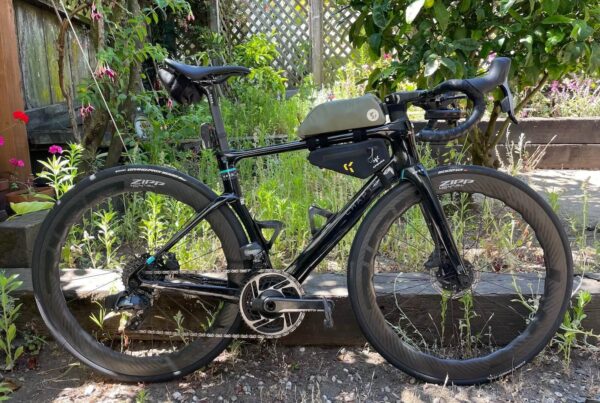This past week, it’s been a beautiful autumn here in the Pacific Northwest, with blue skies and sunny days reminding us of autumns past.
Two years ago yesterday, our idyllic Portland autumn was shattered by tragedy; in the aftermath, Portland was transformed, in ways that we would perhaps not have foreseen, had our autumn then been as peaceful as the one we are basking in now.

Tracey Sparling
Tracey Sparling was an art student at the Pacific Northwest College of Art, in Portland, Oregon. She had transferred there after her freshman year at Syracuse University, because she was homesick. On October 11, a typical autumn day in Portland, Tracey was on her bike, riding back to school after taking her lunch break at home. As she approached the light at West Burnside and SW 14th, she slowed and came to a stop next to a cement truck. When the light turned green, the driver turned right, knocking Tracey to the ground, killing her within moments of the crash. She was 19 years old.
The next night, Portland cyclists, shocked at the senseless death of one so young, turned out en masse for a memorial ride to the site, where a ghost bike had been placed in memoriam.
Eleven days later, Portland cyclist Brett Jarolimek was riding in the bike lane on N. Interstate Ave. He was passed by a garbage truck, which then stopped at the bottom of the hill, the driver appearing to wait for Brett to pass before completing his right turn. Brett didn’t know it, but he was approaching a classic “bait and hook”—the driver seems to be waiting for the cyclist to pass before turning (that’s the bait), but then, at the last moment, turns (that’s the hook). In this case, as Brett began to pass the truck, the driver turned right, directly across his path, killing him instantly.

Brett Jarolimek’s bike. Photo: © Bob Mionske
Portland’s stunned cyclists paid tribute to the popular cyclist and talented artist with a ghost bike, a memorial service held at the Pacific Northwest College of Art (Brett’s alma mater, which, eerily, was also where Tracey was enrolled), a memorial lap at the Cross Crusade, a memorial ride, and with a memorial fund and plans for a permanent Memorial at the intersection where he was killed.
Immediately following these tragic deaths, controversy erupted over the Portland Police Bureau’s handling of the two investigations. Initially, police declined to cite the driver of the cement truck that turned across Tracey Sparling’s right of way. Despite the fact that Tracey had broken no laws when she rolled up to the light and stopped, because she had stopped next to the truck, in the driver’s blind spot, police determined “that there’s just no way he could have seen her.” Thus, in their reasoning, because the driver didn’t know she was there when he turned, it was inappropriate to cite him for failing to make sure that the bike lane was clear before turning across it.
Traffic Division investigators repeated the decision with the truck driver who right-hooked Brett Jarolimek. As the Portland Police Bureau explained,
“..yielding the right of way, and determining whether a traffic violation has occurred, comes down to a matter of perception. Basically, the driver has to perceive he has to yield the right of way.”
For Portland’s legal experts, this revelation was stunning—Portland Police had a deeply flawed understanding of the laws they were charged with enforcing. Traffic investigators had inserted a non-existent requirement into the law that the driver has to “perceive” the need to yield the right of way before the driver can be held accountable for failing to yield the right of way. Thus, according to the interpretation the Portland Police were offering, a driver could only be held accountable for failure to yield if the driver “perceived” the need to yield, and nevertheless did not yield. This flawed interpretation effectively made a violation of the statute (Failure to yield to rider on bicycle lane) an intentional act, rather than the negligent act the statutory language contemplates.
There was more—Portland Police were shifting the blame from the driver to Brett, suggesting that Brett’s speed as he approached the truck was actually responsible for the driver’s failure to perceive a need to yield. Note that police were not alleging that Brett had violated any speed laws (his speed was estimated to be 21 MPH in a zone with a 30 MPH speed limit). Instead, they seemed to be suggesting that Brett should have been proceeding at a pace that was slow enough that he could have avoided a collision when the driver right-hooked him.
These twin revelations led to accusations that the Portland Police Bureau was exonerating the driver, an allegation that aroused further outrage when it was revealed that the passenger-side mirror on the truck was broken, and that the driver had an extensive record of traffic violations.
Then, almost unbelievably, it happened again. Ten days after Brett’s death, Siobhan Doyle was riding her bike to work on N. Interstate. As she crossed the same intersection where Brett had been killed, a driver passed her and immediately turned right, hitting Doyle. Fortunately, Doyle survived the collision, although she suffered serious but non-life-threatening injuries.
And again, the Portland Police Bureau looked for an easy excuse to do nothing—and perhaps not surprisingly, found it.
This time, even though police were already directing traffic around the accident scene, they refused to conduct an investigation, because according to department policy, Doyle’s injuries were not “trauma level,” and thus, did not warrant an investigation:
“Officers do not issue citations for a moving violation unless they have conducted an investigation. In cases like today’s collision there will be no citations issued because the collision did not meet the criteria for investigation.”
Within the space of three weeks, two cyclists had been killed, and a third cyclist had been seriously injured, all by drivers who right-hooked the cyclists they hit. In response, Portland’s cyclists organized a rally for transportation equality around the theme “We are all traffic.”
A rally might have only been momentarily empowering, before fading into memory, had Portland’s attention stopped there. But the rally, held on November 17, just eleven days after Doyle’s near-brush with a more gruesome fate, and which had even been attended by Portland Police Chief Rosie Sizer, was only the beginning.
The day Siobhan Doyle was hit, the intersection where she and Jarolimek had been hit was temporarily closed to right turns by the Portland Department of Transportation. That closure was made permanenteighteen months later.
With the leadership and support of then-Commissioner (and now Mayor) Sam Adams, PDOT began to install bike boxes at high-risk intersections, including the intersection where Tracey Sparling was fatally right-hooked.
In the next year, Portland also initiated a series of educational outreach events for cyclists—an idea which, as we reported in Legally Speaking, the London Borough of Lambeth took to an even higher level, requiring bus and truck drivers working for the city to take cycling safety courses, including on-bike instruction, and making low-cost cycling safety coursesavailable to any interested resident of Lambeth. As we reported, the Portland approach implies that the truck drivers involved in the fatal accidents were not at fault, while the London approach implies that truck drivers have a duty of care to avoid hitting cyclists.
The differences between American and European approaches to cyclist safety didn’t end with education:
• In Portland, city trucks were fitted with safety guards. In contrast, in Europe, all trucks, whether public or private, have been required to be fitted with safety guards since 1989.
• In Portland, cyclists are told not to ride in the blind spot of trucks. In Europe, all heavy trucks are required, as of March 31 of this year, to be fitted with equipment that eliminates blind spots.
• In Portland, the cyclists would be required to prove that the drivers were negligent in hitting them. In contrast, in the Netherlands, a driver is presumed to be negligent in any collision involving a cyclist, unless the driver can introduce evidence rebutting that presumption.
In addition to the safety initiatives Portland enacted, the Police Bureau changed its policy regarding crash response. When a negligent driver crashed into Siobhan Doyle, police policy was that crashes resulting in trauma-level injuries would be investigated, while crashes involving lower-level injuries would only be investigated at the responding officer’s discretion. Following Doyle’s crash, the policy was reviewed, and some two months later, Portland Police announced a new policy of investigating any collision between a driver and a cyclist that results in a trip to the hospital.
The policy, safety, and infrastructure initiatives announced by the city were tempered by the mixed enforcement response to the drivers involved. On January 10, 2008, the Multnomah County District Attorney announced that he would not be filing any criminal charges in the crash causing Tracey Sparling’s death. Five days later, the District Attorney announced that there would also be no criminal charges filed in the crash causing Brett Jarolimek’s death.
With these decisions, the police were free to decide whether to cite the drivers for failure to yield to a bicyclist in the bike lane; on January 22, Portland Police reversed their earlier position on the Tracey Sparling collision, and cited the driver for failure to yield. However, the police also announced that they would not be citing the driver who right-hooked Brett Jarolimek.
Because the police did not investigate the crash that sent Siobhan Doyle to the hospital, they would not be issuing any citations to the driver that right-hooked her. However, in Oregon, any person is authorized by law to cite and prosecute a driver for a traffic infraction, and Portland attorney Chris Heaps volunteered his time to assist Doyle in citing the driver who hit her. That effort, which was subjected to the mother of all official runarounds (including official efforts by the Portland Police Bureau to obstruct his case), paid off when the driver pleaded no contest at trial. Subsequently, based on his prior research, and his conversations with Heaps, Portland attorney Ray Thomas published a how-to guide for cyclists who want to cite and prosecute drivers who violate a traffic law.
Two years later, the Portland Police Bureau has yet to revise its erroneous interpretation of the failure to yield statute, so there remains a likelihood that in any future right-hook collision, traffic investigators will continue to misinterpret the law. As a result, we can expect that at least some drivers who fail to yield to a cyclist will nevertheless escape enforcement action by the police. In those instances, it will remain the responsibility of cyclists—or their survivors—to enforce the laws themselves. It remains to be seen whether, in future incidents, the Portland Police Bureau will continue to obstruct the private prosecutions that the law allows.
Although the official legal response to negligent injuries and homicide on Portland’s streets amounted largely to a shrug of the official shoulders, the cyclists still had some legal recourse. Brett Jarolimek’s family filed suit against the garbage company and their driver on June 4 of 2008. On November 6, Siobhan Doyle filed suit against the city, after the driver’s insurance company paid her up to the policy limits. And finally, on March 17 of this year, Tracey Sparling’s family filed suit against the cement company and their driver. This past week, Doyle’s suit against the city was settled; we do not have information regarding the status of the Sparling and Jarolimek lawsuits.
After two tragic cyclist deaths at the hands of right-hooking drivers, and a close call for a third cyclist, Portland was able to breathe a collective sigh of relief that not a single cyclist was killed in 2008. Although there have been a few cyclist deaths in Portland this year, there hasn’t been another due to a right hook. Certainly, drivers continue to right hook Portland cyclists. Nevertheless, the green bike boxes seem to have worked, probably due to a combination of factors. Because the bike box requires drivers to stop behind the box, and allows cyclists to stop within the box, cyclists are no longer required to be positioned in the turning motorist’s blind spot. Furthermore, the boxes themselves serve as a visual reminder to motorists that cyclists are on the road, and that drivers must exercise due care when turning across the adjacent bike lane. They also serve as a visual reminder to cyclists about where they can—and should—safely position themselves at intersections. thus, the bike boxes not only allow cyclists to reposition themselves on the road, they work to raise the consciousness of both motorists and cyclists.

The Bike Box at W. Burnside and SW 14th. Photo: © Rick Bernardi
It’s impossible to know how many lives—if any—have been saved by the bike boxes. The only thing we do know is that since the bike boxes were installed, no driver has right-hooked a cyclist at any intersection with a bike box. And maybe that’s all we need to know.
The official infrastructure responses to the fatal collisions were generally welcomed. However, the official initiatives were not the only initiatives brought to fruition. One of the more heroic responses, official or otherwise, to the deaths of Tracey Sparling and Brett Jarolimek came from Michael Hall, Dean of Student Services at the Pacific Northwest College of Art. In the wake of tragedy, Hall worked tirelessly to promote and enhance bike safety at the college. In an era when other colleges are banning bikes, or issuing citations to students for “violations” of non-existent laws, Hall went above and beyond, actually promoting bike use by converting three automobile parking spaces to fifty-four bike parking spaces. A future roof over the bike racks is planned in memory of Tracey and Brett.

Bike parking at PNCA. Photo © Rick Bernardi
Two years ago, a young cyclist died when she stopped where the city expected her to stop. Her death, and the crashes that followed, set in motion changes that have made the city safer for cyclists. And for two years, Tracey’s ghost bike has stood, memorializing her to all who pass. Now, feeling that the time is right, Tracey’s family plan to remove her ghost bike next weekend from the intersection where it has stood for two years.

Tracey Sparling’s ghost bike, with October garlands. Photo: © Rick Bernardi
For the living, life goes on. For those we’ve lost, they remain forever frozen in that moment we knew them, forever young, forever punctuated by tragedy, forever remembered and loved.

Spoke card, Tracey Sparling’s ghost bike. Photo: © Rick Bernardi
It’s another beautiful autumn in the Pacific Northwest this year.
(I’d like to offer a special thanks to Jonathan Maus at BikePortland. It’s one thing to remember what happened when tragedy struck years ago; it’s another thing entirely to have every event archived for future reference. Thanks Jonathan.)




Thank you for the article, and the lasting tribute. I was incensed when these events happened, and attended the rallies and remembrance rides. I’m glad that in some ways cycling in Portland is safer than it was then. I point to these events, and the aftermath, when discussing bicycle infrastructure issues with Seattle friends. We have a long way to go, but we are making progress.